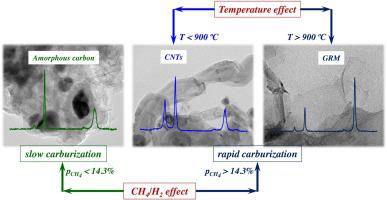Catalysis Today ( IF 5.3 ) Pub Date : 2020-12-24 , DOI: 10.1016/j.cattod.2020.12.003 F. Cazaña , N. Latorre , P. Tarifa , C.J. Royo , V. Sebastián , E. Romeo , M.A. Centeno , A. Monzón

|
This work explores the preparation of graphene-related materials (GRMs) grown on stainless steel foams via catalytic decomposition of methane (CDM). The main active phases for the reaction are the Fe nanoparticles segregated from the stainless-steel after the activation stage of the foam. The effect of the feed composition and reaction temperature has been studied in order to maximize the productivity, stability and selectivity to GRMs. The maximum productivity attained was 0.116 gC/gfoam h operating at 950 °C with a feed ratio of CH4/H2 = 3 (42.9 %CH4:14.3 %H2). The carbonaceous nanomaterials (CNMs) obtained were characterized by X-Ray diffraction, Raman spectroscopy and by transmission and scanning electron microscopy. The parameters of the kinetic model developed are directly related to the relevant stages of the process, including carburization, diffusion-precipitation and deactivation-regeneration. The balance among these sequential stages determines the overall performance of the activated foam. In conditions of rapid carburization of the Fe NPs (pCH4 > 14 %), the productivity to CNMs is favoured, avoiding an initial deactivation of the active sites by fouling with amorphous carbon. After a rapid carburization, the selectivity to the different CNMs is governed by the ratio CH4/H2, and mainly by the temperature. Thus, the formation of GRMs, mainly Few Layer Graphene (FLG) and even graphene, is favoured at temperatures above 900 °C. At lower temperatures, carbon nanotubes are formed.
中文翻译:

AISI 316L-不锈钢泡沫对高温催化分解甲烷形成石墨烯相关纳米材料的性能
这项工作探索了通过甲烷催化分解 (CDM) 在不锈钢泡沫上制备石墨烯相关材料 (GRM)。反应的主要活性相是在泡沫活化阶段后从不锈钢中分离出来的 Fe 纳米颗粒。已经研究了进料组成和反应温度的影响,以最大限度地提高 GRM 的生产率、稳定性和选择性。获得的最大产率为0.116克Ç /克泡沫小时,在950℃的工作用CH的进料比4 / H 2 = 3(42.9%CH 4:14.3%H 2)。获得的碳质纳米材料 (CNM) 通过 X 射线衍射、拉曼光谱以及透射和扫描电子显微镜进行表征。所开发的动力学模型的参数与过程的相关阶段直接相关,包括渗碳、扩散-沉淀和失活-再生。这些连续阶段之间的平衡决定了活性泡沫的整体性能。在 Fe NPs 快速渗碳的条件下(p CH4 > 14%),CNMs 的生产率是有利的,避免了活性位点因无定形碳结垢而导致的初始失活。快速渗碳后,对不同 CNM 的选择性取决于 CH 4 /H 2的比例,主要是受温度影响。因此,在 900 °C 以上的温度下有利于 GRM 的形成,主要是少层石墨烯 (FLG) 甚至石墨烯。在较低温度下,形成碳纳米管。


























 京公网安备 11010802027423号
京公网安备 11010802027423号